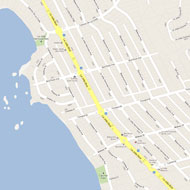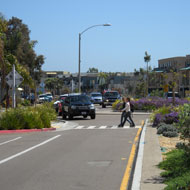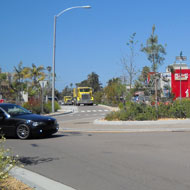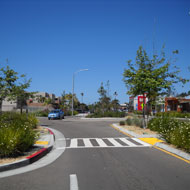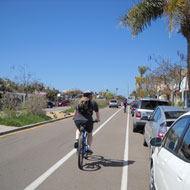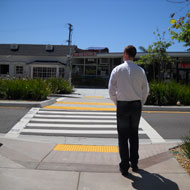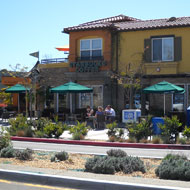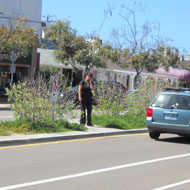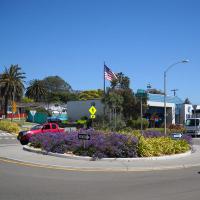
San Diego, CA
Background
The Bird Rock neighborhood is located south of La Jolla in the city of San Diego. It is a coastal community with a population of about 16,000. La Jolla Boulevard is the primary vehicle route to La Jolla from the south, connecting to a network of residential and collector streets in the Bird Rock area. There had been safety and air pollution problems because of cut-through traffic on the wide corridor. The residents are concerned about the high rates of speed (38-42 mph), difficulty of crossing La Jolla Boulevard and peak hour congestion at a local school. In addition, a shortage of parking in the area, lack of comfortable public space, aesthetic condition and financial stagnation of area businesses were additional issues that needed to be addressed. The wide, heavily trafficked road functioned as a barrier that divided the neighborhood physically and psychologically.
A comprehensive traffic management plan was developed, addressing residents’ concerns about potential congestion and spillovers due to reduced road capacity. Through a multitude of community meetings and charrettes, the Traffic Plan was developed and approved by the community in 2003. The City Council approved the plan the following year. After three years of design process, the first phase of construction began in 2007.
The plan includes a series of roundabouts, medians, diagonal parking on the west side and parallel parking on the east side. On La Jolla Boulevard, pedestrians once had 68 feet of pavement to cross when crossing the street. With implementation of roundabouts and medians, pedestrians would cross only one traffic lane or 14 feet of pavement at a time. The street was redesigned as one lane in each direction with a 10-foot median that serves as pedestrian refuge area. There are two travel lanes that are capable of carrying existing traffic of 20,000 vehicles per day, as well as additional growth in traffic up to 25,000 vehicles per day.
The main feature of the project is a series of five modern roundabouts where La Jolla Boulevard intersects with five collector streets. The roundabouts on La Jolla Boulevard reduce the number of traffic lanes from four or five to two -- one in each direction. Speeds through roundabouts are controlled at 15-20 mph. Vehicles of all sizes are able to make all through movements at these roundabouts. Yet some restrictions apply to oversize vehicles making some turns. The street redesign also includes relocation and reconfiguration of bus stops, and new bus pads and bus benches. Various traffic calming measures are used to calm the generally continuous flow traffic. These include bulbouts (extension of sidewalks that reduces the pedestrian crossing distance), speed bumps using a new split-hump design to reduce speeding, raised center medians, and street markings. Median islands are about 10 feet wide, and like roundabouts, well landscaped to add color and aesthetics to the area. The project includes construction of new sidewalks and provides 30 additional parking spaces along La Jolla Boulevard, including diagonal and parallel parking in a five-block area. Cyclists can use Class II Bike Lanes on La Jolla Boulevard from the south to Colima Street and on La Jolla Hermosa from Colima Street to Cam de la Costa. North of Cam de la Costa, the bike lane becomes a bike path. Bike lanes are 6 feet wide from the curb face to the center of the 6- to 8-inch wide lane stripe. Bike lanes are 6 feet to 7 feet wide when placed next to parallel parking. Several design improvements have been incorporated to better accommodate pedestrians with impaired vision who are crossing at roundabouts, including construction of new intersection crossings at about two vehicle lengths behind the roundabout yield line, installation of rumble strips at exits and tangential approaches to crosswalks, planting of low-profile shrubs around the circles all the way to the crosswalks, and construction of in-pavement flashers on La Jolla Boulevard.Lessons Learned
Potential Benefits:
- Slows traffic by using roundabouts to slow traffic speed and provide inviting gateways.
- Reduces traffic lanes to reduce the crossing distance, reduce pedestrian accidents, and make additional space available for intersection and median beautification, including landscaped center medians.
- Uses phased construction to allow issues discovered during the first phase to be improved during the second phase. Create a desirable environments for buildings to actively engage the street by creating well-landscaped medians, roundabouts and sidewalk planting areas.
Potential Issues:
- Right-of-way impacts: At some intersections, the roundabout design resulted in invading the private right-of-way, relocating driveways and utilities, or reducing sidewalk width.
- Large vehicle access: Some issues were experienced with access for larger vehicles. A low-bed trailer truck got stuck at the Colima roundabout. Some trucks were running over the curb lines at entry and exit, and buses got stuck at roundabouts.
- Maintenance: To maximize the desirable benefits of roundabout traffic calming, a high level of planting is needed in the medians and roundabouts. Low maintenance landscaping is necessary to reduce maintenance issues.
- Long blocks: Despite the well-designed pedestrian sidewalks, the distance between sidewalks is very long. People often dodge traffic and cross in the middle of the blocks, despite signs discouraging pedestrians not to do so.
- Construction issues: Some unforeseen conditions were encountered, such as shallow utilities, existing street crosssections that were thicker than anticipated, railroad tracks, poor soils, and addressing potential delays and drainage issues.Traffic detours and pedestrian and parking access during construction also needed to be addressed.
Sources
Adams, Lisa, P.E., Construction Manager. “Bird Rock Traffic Flow Improvements La Jolla Boulevard Roundabouts” City of San Diego Engineering & Capital Projects Department
Arnold, M., Chui, G., and Lupo, D., P.E. “Roundabout Product Demonstration Showcase” Presentation on December 10, 2008, City of San Diego Engineering & Capital Projects Department
Pazargadi, Siavash, P.E. “What is Roundabouts?” Presentation on Dec.10, 2008
Photo Sources
MIG, Inc.

